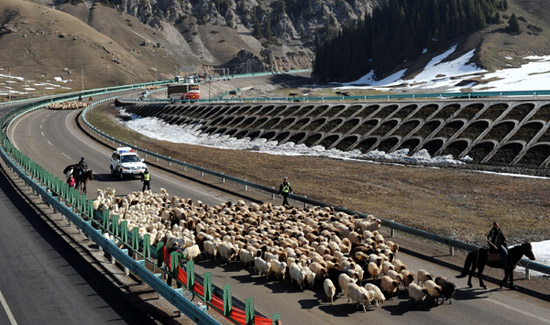
 |
| Sheep are herded on the highway in Huocheng county, Xinjiang Uygur autonomous region, on Sunday to head for greener pastures as spring arrives. GE HANXU / FOR CHINA DAILY |
Tens of thousands of sheep took to a highway in Xinjiang Uygur autonomous region on Sunday as shepherds moved their herds to fresh pastures, in an annual migration with a difference.
The nomadic shepherds from Ili Kazak autonomous prefecture were allowed access to a 23 km stretch, during what is an important time when they move their flock from winter to spring pastures.
Police were on hand to make sure the traffic was stopped, as the sheep passed by.
The expressway, linking Sayram Lake and Guozigou Valley in Xinjiang, was only opened last year, and has become a convenient option for the herders, as the valley is the only route for them to switch pastures.
The authorities previously opened the section to the shepherds when they moved their livestock in spring and autumn.
More than 230,000 sheep and 1,200 nomadic households are expected to pass between March 15 and 30, police said.
Herds are kept 50 to 100 meters apart and are only allowed access to the highway between 8 am and 8 pm.
A herd takes an average of six hours to cover the highway section and another three days and nights to arrive at the pasture. It is doubly difficult at this time of year, as 98 percent of the sheep are pregnant.
This rotational grazing is believed to save a shepherd household up to 80,000 yuan ($12,870) a year in feeding costs, China Central Television reported.
"We had to keep reminding drivers along the way to slow down, to protect the sheep," Ge Hanxu, an officer with Ili traffic police, said on Sunday.
According to Ge, more than 150,000 vehicles use the section of highway every day and traffic accidents can be costly for the herders.
















 Now you can use mobile phone to 'call' the dead
Now you can use mobile phone to 'call' the dead


![]()
